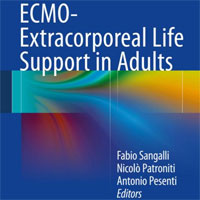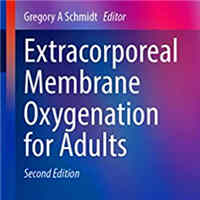Tag: cannulation
ECMO-Extracorporeal Life Support in Adults
Extracorporeal membrane oxygenation (ECMO) has been in clinical use for some 40 years, but it is only in the past decade that its application in the treatment of life-threatening circulatory and respiratory failure has truly... read more

Levosimendan Role in ECMO for Refractory Cardiac Arrest
Levosimendan use in extracorporeal cardiopulmonary resuscitation (ECPR) did not improve survival. Neurological outcome could be representative of the short- and long-term outcomes. Future well-designed randomized trials... read more
Late Hemorrhagic Complication and Unilateral Neck Edema Related to Cannulation in VV-ECMO
This is a rare case of delayed acute unilateral neck edema that developed during veno-venous extracorporeal membrane oxygenation (VV-ECMO). This case underscores the importance of considering a wide range of differential... read more
Exploring the Effectiveness of HFNC in the Neurointensive Care Unit
The high flow nasal cannula (HFNC) is becoming increasingly prevalent in both adult and pediatric general intensive care. Despite limited reporting in neurocritical care, we have successfully utilized HFNC in our cohort... read more
Central vs. Peripheral VA-ECMO Cannulation on Postoperative Graft Dysfunction in Lung Transplantation
Lung transplantation (LTx) is the definitive treatment for end-stage pulmonary diseases, with venoarterial extracorporeal membrane oxygenation (VA-ECMO) used as a common perioperative support. However, it remains unclear... read more
Extracorporeal Life Support: The ELSO Red Book, 6th Edition
Written by over two hundred experts from around the world, this new edition is the definitive reference text on Extracorporeal Life Support, providing both the latest evidence and practical advice on how to clinically manage... read more

Intranasal Dexmedetomidine vs. Inhaled Nitrous Oxide for Pediatric Procedural Sedation and Analgesia
The results of this clinical trial support that IN DEX is not inferior to 50% nitrous oxide in providing analgesia for a painful procedure among children 3–15 years of age. Furthermore, IN DEX can be considered as an alternative... read more
Non-Intensive Care Unit Feasibility for Ambulatory VV-ECMO Patients
Our data suggests that ambulatory veno-venous extracorporeal membrane oxygenation (VV-ECMO) patients may tolerate less than ICU level of care and may even progress to outpatient management as ECMO technology continues to... read more
ECPR in 2023
Extracorporeal cardiopulmonary resuscitation (ECPR) is invasive and resource intense. Data suggesting a survival benefit in patients after OHCA and ECPR derive from retrospective registries and meta-analyses. In order to... read more
Ultrasound-Guided Infraclavicular Axillary Vein vs. Internal Jugular Vein Cannulation in Critically Ill Mechanically Ventilated Patients
No difference was found between the real-time ultrasound-guided out-of-plane cannulation of the IJV and the infraclavicular real-time ultrasound-guided in-plane cannulation of the AXV. Both techniques are equally efficient... read more
Extracorporeal Membrane Oxygenation for Adults (Respiratory Medicine)
This new edition presents an evidence-based review of extracorporeal membrane oxygenation (ECMO) for adults, with a particular focus on veno-venous (VV) ECMO. Due to the dramatic impact of COVID-19, the number of institutions... read more

Time from Infiltrate on Chest Radiograph to VV ECMO in COVID-19 Affects Mortality
Venovenous extracorporeal membrane oxygenation (VV ECMO) has been used to treat severe coronavirus disease 2019 (COVID-19) acute respiratory distress syndrome; however, patient selection criteria have evolved throughout the... read more
Extracorporeal Membrane Oxygenation for Adults
This new edition presents an evidence-based review of extracorporeal membrane oxygenation (ECMO) for adults, with a particular focus on veno-venous (VV) ECMO. Due to the dramatic impact of COVID-19, the number of institutions... read more

Expert Consensus on PeRcutaneous Cannulation for ECPR
We present inclusion and exclusion criteria and a comprehensive, detailed, generalizable list of best practices for extracorporeal cardiopulmonary resuscitation (ECPR) initiation following refractory out-of-hospital cardiac... read more
High Flow Nasal Cannula: Physiological Effects and Clinical Applications
This book presents the state of the art in high-flow nasal cannula (HFNC), an oxygen therapy technique that has recently proven to be a very promising approach to supporting respiratory function in several medical fields. In... read more

Arterial Carbon Dioxide and Acute Brain Injury in VA-ECMO
Acute brain injury (ABI) occurs frequently in patients receiving venoarterial extracorporeal membrane oxygenation (VA-ECMO). We examined the association between peri-cannulation arterial carbon dioxide tension (PaCO2) and... read more
Setting up a Rescue ECLS Program
Extracorporeal life support (ECLS) is a high-risk, lifesaving medical treatment that is typically limited to centers that can support a comprehensive ECLS program. Rescue programs can bridge the gap in care between ECLS centers... read more
Percutaneous vs. Surgical Cannulation for Femoro-Femoral VA-ECMO in Cardiogenic Shock Patients
Compared with surgical cannulation, percutaneous cannulation was independently associated with lower in-hospital mortality and fewer complications. Among 12,592 patients meeting study inclusion, 9,249 (73%) underwent percutaneous... read more
Subclavian vs. Femoral Arterial Cannulations During ECMO
During peripheral extracorporeal veno-arterial membrane oxygenation (VA-ECMO) support, subclavian arterial cannulation provides, in comparison to femoral arterial cannulation, an anterograde flow which may prevent from left... read more
Respiratory Drive in Sepsis and Septic Shock Patients: Modulation by High-flow Nasal Cannula
Patients with sepsis and septic shock of extrapulmonary origin present elevated respiratory drive and effort, which can be effectively reduced by high-flow nasal cannula. 25 nonintubated patients with extrapulmonary sepsis... read more
Expanding ECMO Cannulation Strategies in Neonatal Respiratory Failure
Infants with refractory respiratory failure who require extracorporeal membrane oxygenation (ECMO) have traditionally been cannulated via the venoarterial route or by using a dual-lumen venovenous cannula in the right internal... read more
The Influence of Airflow Via High-Flow Nasal Cannula on Duration of Laryngeal Vestibule Closure
The purpose of this experimental study was to investigate the influence of airflow via high-flow nasal cannula (HFNC) on the duration of laryngeal vestibule closure (dLVC) and Penetration-Aspiration Scale (PAS) scores. 29... read more









